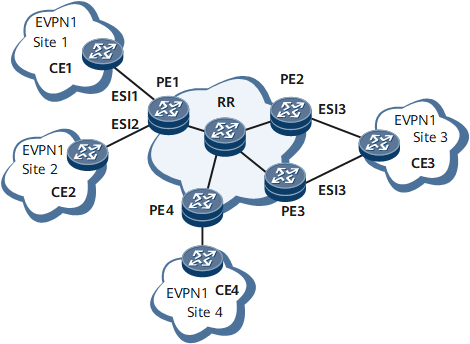Configuring Common EVPN Functions
Configuring Common EVPN Functions involve configuring EVPN instances, BGP EVPN peer relationships, BGP EVPN RRs, and ESIs.
Usage Scenario
EVPN is used for Layer 2 internetworking.
Configure an EVPN instance on each PE and bind the EVPN instance on each PE to the interface that connects the PE to a site.
Configure EVPN source IP addresses to identify PEs in the EVPN networking.
Configure ESIs for PE interfaces connecting to CEs. PE interfaces connecting to the same CE have the same ESI.
Configure BGP EVPN peer relationships between PEs on the backbone network to allow MAC addresses to be advertised over routes.
Configure RRs to decrease the number of BGP EVPN peer relationships required.
Pre-configuration Tasks
Before configuring common EVPN, complete the following tasks:
Configure an IGP on the backbone network to ensure IP connectivity.
Configure MPLS LDP or TE tunnels on the backbone network.
Configure Layer 2 connections between CEs and PEs.
- Configuring an EVPN Instance
- You can configure EVPN instances on PEs to manage EVPN routes.
- Configuring an EVPN Source Address
- An EVPN source address uniquely identifies a PE in EVPN networking.
- Binding an Interface to an EVPN Instance
- After an interface is bound to an EVPN instance, the interface becomes a part of the EVPN. Packets entering the interface will then be forwarded based on EVPN instance traffic forwarding entries.
- Configuring an ESI
- An ESI must be configured on a PE interface connected to a CE. The same ESI must be configured for PE interfaces connecting to the same CE.
- Establishing a BGP EVPN Peer Relationships
- After two PEs establish a BGP EVPN peer relationship, they can exchange EVPN routes.
- (Optional) Configuring the Global Redundancy Mode
- A PE's global redundancy mode determines whether the PE can work with other PEs in load-balancing mode.
- (Optional) Configuring a BGP EVPN RR
- Configuring a BGP EVPN RR helps reduce the number of required BGP EVPN peer relationships, and therefore saves network resources.
- (Optional) Setting a Redundancy Mode and DF Priority per ESI Instance
- In a scenario where multiple CEs are dual-homed to PEs, if you want to use different transmission modes (load balancing and non-load balancing) to send unicast traffic to different CEs or if you want to specify DFs for traffic forwarding by setting priority values, you can set a redundancy mode and DF priority values based on ESIs.
- (Optional) Associating DF with BFD
- When a CE is dual-homed to PEs, you can associate DF with BFD. If an access link fails, this configuration accelerates the primary/backup DF switchover.
- (Optional) Improving the switching performance of broadcast traffic if the master board fails
- You can enable the device to deliver backup leaf node information to the standby interface board, which helps improve the switching performance of broadcast traffic if the master board fails.
- Verifying the EVPN Configuration
- After configuring EVPN, verify the operating status and information about EVPN functions.
